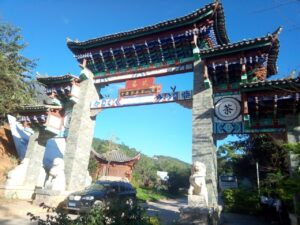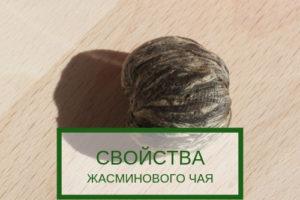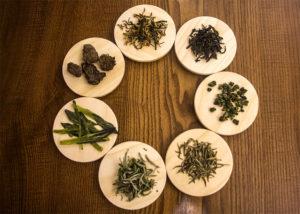At the end of November 2018 we were in Japan and, of course, we couldn’t pass by tea plantations…Why Wazuka? There was not much information on the English-speaking internet about the plantations open for visiting, and even on Sunday. One of the few places with an accessible site and clear road is Wazuka. Since we were planning to leave for Hiroshima the next day, we decided to go here.
Kyoto is rightly considered the center of the tea schools of the Way of Tea in Japan. The ancient tea dynasties, originating from Master Sen no Rikyu, are located in Kyoto. The most famous schools of Urasenke, Omotosenke and others have been using only local tea for centuries.

Kyoto Prefecture has many tea bush sites. Most often, the raw materials for loose tea and matcha tea are brought to Uji for processing and packing. Tea came to Uji from China around the 8th century AD. Several different Japanese varieties of tea bush grown in the area are now known, bearing the name of Uji tea. The same local varieties have spread throughout the prefecture.Nowadays, Uji is quite a large city with a population of about 183,000 people and dense buildings. There has also been a strong increase in demand for tea both within Japan and for export. Tea plantations have greatly expanded and occupied several counties in Kyoto Prefecture. This includes Soraku County, where the village of Wazuka is located.
But on the labels of the finished tea packs you will still read that it is tea from Uji in Kyoto. In this article, we’ll stick to spelling place names like Wikipedia to make it easier for you to make your itinerary. Hence the names “county” and “prefecture” to avoid confusion. We hope our travel notes will help other tea lovers to visit this wonderful place. From Kyoto Central Station, the trip takes an hour and a half. We used the JR line, for which we bought a weekly ticket in advance. It is very convenient, but you need to order these tickets in advance in your country and then activate them in Japan at the railway station with your passport.
Don’t be afraid to use Japanese trains on your own. Everywhere there are inscriptions in English and even without knowing Japanese you will get to the right station. The older generation often doesn’t know English, but all the people are very friendly and willing to help. The road to the plantations is no more complicated than taking the subway with one transfer and your hometown bus. It is best to plan a trip to the plantations in the morning for a full day or 2 days with an overnight stay. It gets light early in Japan, but it also gets dark at 5pm. In the countryside, many stores, cafes and cultural centers close around 5 p.m. In Wazuka, the combo (a store and snack bar by the road) and the bus runs after sunset. In the evening, the bus runs once an hour.
So, from Kyoto station, you take the JR line to Nara almost to the end. Before you get one stop to Nara, get off the train at Kizu station. At this station, you need to change to another Yamato Road Express line and take another stop (about 6 minutes) on the local train to Kamo station. At the station, get off the west exit and take the 66 bus to Osugi to the Wazuka-cho stop.
The bus fare is 480 yen per person, you pay the driver and it is better to have small coins, you can’t pay with a bank card on Japanese buses. The bus ride to Wazuki takes about 20 minutes along a scenic mountain road along the river and tea terraces.
It’s hilly and in the evening the temperature can be a few degrees cooler than Kyoto. Bring warm clothes. When you get off at the Wazuka-kyo stop, you will immediately see the main attractions of the village – the tea terraces and Yamajin Cafe, which can be translated as “Highlander”.

Stop the bus back to Camo at the Lawson store (this is the combi). Take a picture or write down the bus schedule back and head over the bridge to the tea cafe. At the Highlander Cafe you can pick up an English-language map and a rental bike. A bike is highly recommended if you intend to see as much as possible in a day. Walking up and down the hills is quite tiring and long. Have a teapot of aromatic local sencha and go for a walk.
In the surrounding area, besides the tea terraces, there are several temples, a beautiful pagoda, a Buddhist statue of Maitreya carved into the rock above the river, the mound of Prince Asaka, sacred cedar trees and many cafes and tea shops. They are all marked on your map. Besides bike rentals at Yamajin Cafe, you can ask for a nice themed tea party or lunch at the Sky Cafe Wazuka view lodge. Often the village council holds various themed fairs and festivals, as there are about 300 tea families living in the village and several local tea brands are sold.

We just happened to be at the Tea Utopia Festival and took the free festival bus from Kamo. The schedule of festivals and other activities is on the website, unfortunately only in Japanese. You can sign up for tea picking, a plantation tour, a cooking class from the grandmothers of the village, a tasting with tea ceremony training in sencha-do (with different varieties of loose leaf tea) or sha-do (with whipping matcha tea). All this is possible by contacting the organizers in English or Japanese in advance. You can order an English-speaking guide or a guide with a car (for a group).
The tea festival was held at the sports stadium, which was all filled with tea and various tea-related merchandise. At 5 o’clock everything was already closed. You have to hand in your bike before that time too, don’t make our mistake and plan your time in advance.

What to buy or eat in Wazuka?
Green tea noodles, tea beer, cookies, sweets, cupcakes and tea cream. Everything you could and could not imagine from tea – exists in Japan. Buy home sencha, gyokuro, matcha and genmaicha teas from different farmers to sample.
In the store opposite the stadium you can pay with your bank card and buy local vegetables from the greenhouse.

If you walk along the Watsuka River towards the post office, you’ll come across an excellent ramen shop (we recommend the tempura tea noodles) and okonomiyaki. And there’s also a cafe with matcha tea and matcha desserts.

Soft gelatto made from the choicest local matcha, traditional yokan and kuzu mochi sweets with added tea is truly a tea utopia. In the village you can stay overnight in a traditional house or hotel. If you want to participate in the tea harvest, plan your trip for May-June or September-October.

There are many plantations of high quality tea growing under cover from the sun in this area. This unique sight deserves your attention. The leaves remain tender and sweet to the taste. There we also saw how tea blooms and what a pleasant aroma its white flowers have. It is a good idea to combine a trip to Nara with the sacred deer and temples and tea activities. Enjoy your new discoveries!

All locations are detailed on google map with exact addresses and phone numbers and tripadvisor (in English).
Website http://wazukanko.com/
Facebook https://www.facebook.com/wazukanko
All photos in the article are from Wazukanko’s Facebook.
Author of the text: Anna Nazarenko, traveler and certified tea master of the Urasenke school.





